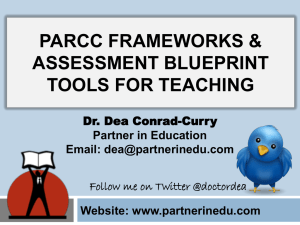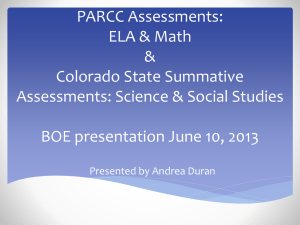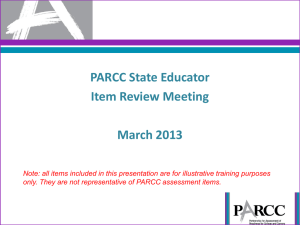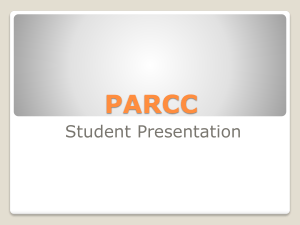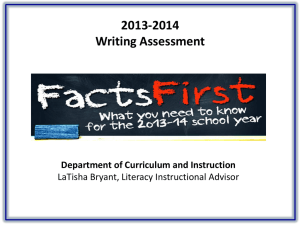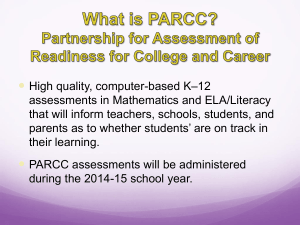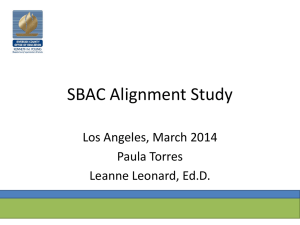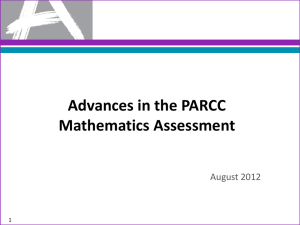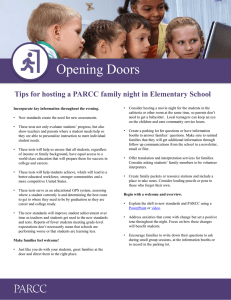PARCC RESEARCH SIMULATION TASK
advertisement
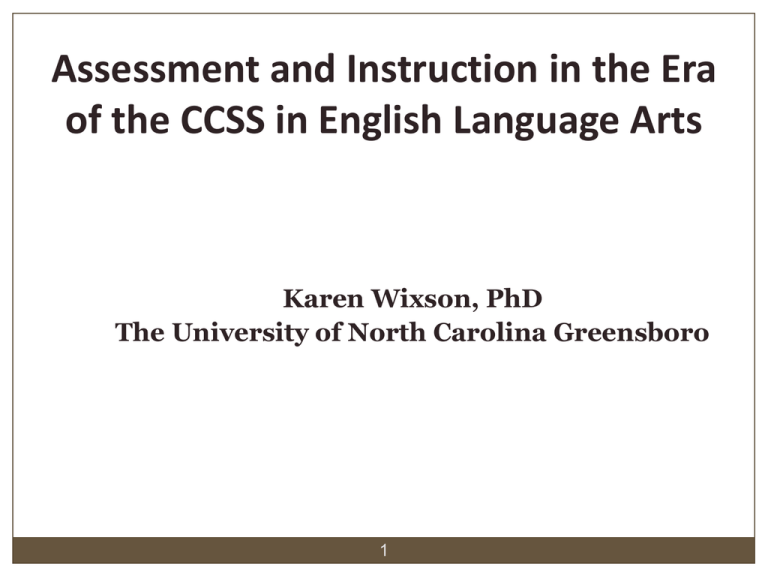
Assessment and Instruction in the Era of the CCSS in English Language Arts Karen Wixson, PhD The University of North Carolina Greensboro 1 Key Shifts in Assessment & Instruction Related to CCSS 2 1. Complexity: Regular practice with complex text and its academic language 2. Evidence: Reading and writing grounded in evidence from text, literary and informational 1. Knowledge: Building knowledge through content rich text (esp. nonfiction) Implications of Shifts 3 Texts Worth Reading: Use of authentic texts worthy of study instead of artificially produced passages Tasks Worthy of Engagement: Activities that focus on substantive content and draw students into deeper encounters Integrated ELA: Instruction and assessment activities that integrate the areas of ELA, the CCSS standards, and ELA with the disciplines Integrated ELA Speaking & Listening Writing Language Reading Instruction & Assessment Standard Integration RI.3.9 W.3.1a L.3.3a RI.3.9 SL.3.4 L.3.6 RI.3.9 W.3.4 L.3.3a MAJOR CLAIMS FOR READING AND WRITING DRIVING NEW ASSESSMENTS 8 Students are expected to: Read closely and analytically to comprehend a range of increasingly complex literary and informational texts (SBAC); read and comprehend a range of sufficiently complex texts independently (PARCC) Produce effective and well-grounded writing for a range of purposes and audiences (SBAC); write effectively when using and or analyzing sources (PARCC) Engage in research and inquiry to investigate topics, and to analyze, integrate and present information (SBAC); build and present knowledge through research and the integration, comparison, and synthesis of ideas (PARCC) ADDITIONAL SBAC CLAIMS 9 Employ effective speaking and listening skills for a range of purposes and audiences (SBAC) Use oral and written language skillfully across a range of literacy tasks (SBAC) TYPES OF ITEMS 10 Types of Items PARCC* SBAC** Multiple Choice Evidence Based Selected Response (EBSR) Selected Response (SR) Technology Enhanced Constructed Response (TECR) Technology Enhanced (TE) Open-Ended Prose Constructed Response (PCR) Constructed Response (CR) Performance Literary Analysis Task Narrative Task Research Simulation Task Various combinations of “stimuli-information processing-product/perf” * PARCC End of Year assessments include EBSR & TESR items, Performance assessments include EBSR, TESR, and PCR items ** SBAC computer adaptive assessments include all 3 item types, performance tasks consist of research questions (SR & CR) and writing prompt The SBAC Assessment System 11 English Language Arts and Mathematics, Grades 3 – 8 and High School Last 12 weeks of year* DIGITAL CLEARINGHOUSE of formative tools, processes and exemplars; released items and tasks; model curriculum units; educator training; professional development tools and resources; an interactive reporting system; scorer training modules; and teacher collaboration tools. INTERIM ASSESSMENT Computer Adaptive Assessment and Performance Tasks INTERIM ASSESSMENT Computer Adaptive Assessment and Performance Tasks Scope, sequence, number, and timing of interim assessments locally determined PERFORMANCE TASKS • 1 ELA , 1 Math • Research SR/CR + writing prompt COMPUTER ADAPTIVE ASSESSMENT (SR, TE, CR) Re-take option Optional Interim assessment system — no stakes Summative assessment for accountability * Time windows may be adjusted based on results from the research agenda and final implementation decisions. 13-Apr-15 Optional Assessments/Flexible Administration Diagnostic Assessment • Early indicator of student knowledge and skills to inform instruction, supports, and PD •Non-summative Summative, Required assessment Mid-Year Assessment •Performance-based •Emphasis on hard-tomeasure standards •Potentially summative Interim, optional assessment Performance-Based Assessment (PBA) • ELA/Literacy Tasks (3) • EBSR, TECR, PCR items • Required End-of-Year Assessment •EBSR, TECR items •Required ELA - Speaking And Listening Assessment • Locally scored • Non-summative, required 12 ADMINISTRATION TIME & SESSIONS 13 Grade PARCC SBAC 3 EOY: 60 min. x 2 sessions Perf: 40-60 min. per task TOTAL: Approx 4.5 hours CAT: 1 hr 45 min Perf: 35 min (stimulus + research Q’s), 70 min (writing prompt) TOTAL = Approx. 3.5 hours 4-5 EOY: 70 min. x 2 sessions Perf: 50-80 min per task TOTAL: Approx 5 hrs 50 min CAT: 1 hr. 45 min Perf: 35 min (stimulus + research Q’s), 70 min (writing prompt) TOTAL = Approx. 3.5 6-8 EOY: 70 min x 2 sessions Perf: 50-85 min. per task TOTAL: Approx. 5 hrs 55 min CAT: 1 hr. 45 min Perf: 35 min (stimulus + research Q’s), 70 min (writing prompt) TOTAL = Approx. 3.5 9-11 EOY: 70 min x 2 sessions Perf: 50-85 min. per task TOTAL: Approx. 5 hrs 55 min CAT: 2 hr. Perf: 35 min (stimulus + research Q’s; 85 min writing prompt) TOTAL = Approx. 4 hours TEXT LENGTH AND DIFFICULTY 14 Grade PARCC SBAC 3 200-800 wds 650 wds 4-5 200-800 wds 750 wds 6-8 400-1000 wds 950 wds 9-11 500-1500 wds 1100 wds -SBAC calls for texts on grade level for “Reading” questions (CAT) and one grade below level for “Writing” (Perf) -PARCC uses grade level rubrics to identify texts as “very complex, moderately complex, or readily accessible” IMPLICATIONS FOR INSTRUCTION 15 Information about assessment texts and tasks indicates that students need: Experience reading “long” grade-level or near grade level texts independently Strategies for dealing with grade level texts if they cannot read them independently Stamina, Motivation and Engagement In addition: Everyone needs to be exposed to rich grade levels texts Students who cannot read grade level texts independently will need instructional level texts as well to improve their basic skills SAMPLE SHORT ANSWER ITEMS 16 SBAC Selected Response Technology Enhanced Constructed Response (Reading) PARCC Evidence Based Selected Response Technology Enhanced Constructed Response PARCC Evidence-Based Selected-Response (Grade 3) 17 Part A Part B What is one main idea of “How Animals Live?” Which sentence from the article best supports the answer to Part A? a.There are many types of animals on the planet. a.“Animals get oxygen from air or water.” b.Animals need water to live. b."Animals can be grouped by their traits.”* c.There are many ways to sort c."Worms are invertebrates.” different animals.* d."All animals grow and change over time.” d.Animals begin their life cycles in different forms. e."Almost all animals need water, food, oxygen, and shelter to live." PARCC Technology-Enhanced ConstructedResponse Item 18 Drag the words from the word box into the correct locations on the graphic to show the life cycle of a butterfly as described in “How Animals Live.” Words: Pupa Adult Egg Larva SBAC Technology Enhanced Vocabulary (Grade 4) SBAC (Brief) CONSTRUCTED RESPONSE 20 Write a paragraph explaining why people who live in moist climates work harder to prevent mold than people that live in dry climates. Include details from the passage about how they prevent mold.” “Based on what you read in the text, do you think cell phones should be allowed in schools? Using the lists provided in the text, write a paragraph arguing why your position is more reasonable than the opposing position.” These can appear as part of the CAT and/or as “research” questions in the Performance assessment IMPLICATIONS FOR INSTRUCTION 21 Information about short-answer questions on assessments indicate that students need: More than basic understanding of text Practice with justifying their understandings from text Opportunities to apply their understanding in different ways Experience with academic vocabulary in context On over-arching emphasis on self-monitoring and fix up SBAC PERFORMANCE TASKS 22 Classroom Activity—20 minutes Research 35 minutes with stimuli/research questions (SR, TE, &/or CR) 1 or 2 stimuli at grade 3; up to 5 for high school At least 3 research questions Writing 70-85 min with Writing prompt Opinion (3-5); argumentative (6-11) Narrative Informational/Explanatory STRUCTURE OF SBAC PERFORMANCE TASKS Performance Task Stimulus* Information Processing Product/Performance • readings Research questions Essay, report, story, • video clips comprehension script • audio clips questions oral presentation • research topic/issue/ simulated internet w/wo graphics, other problem search media • graphs, charts, other Responses to visuals embedded CR questions * Max of 2 at gr 3 and 5 HS 23 SBAC PERFORMANCE TASK: INFORMATIONAL (Grade 4) Animal Defenses (125 min. total) Classroom activity to prepare for Parts I and II (20 min.) Part I: Examine sources, take notes, respond to 3 CR research questions (35 min.) Part II: Write explanatory essay (70 minutes) SBAC PERFORMANCE TASK: CLASSROOM ACTIVITY (Grade 4) 25 Step 1: Orientation to the Topic (4 min.): Indicate that after this activity students will be completing an assessment on the topic of animal defenses. Introduce “defense” and probe students’ understanding to be sure Step 2: Accessing the Stimuli (13 min.)—show Animal Defenses video and lead whole class discussion using specific questions Step 3: Clarify Expectations for Writing Task (3 min.)— Explain what students are expected to do in their explanatory essay according to “directions” SBAC PERFORMANCE TASK: STIMULI & RESEARCH QUESTIONS (Grade 4) 26 Students have 35 minutes to: read an article and watch a video about what animals themselves from danger (stimuli) take notes (note-taking “grid” provided) answer 3 CR questions about the sources What does the article “Animal Roll-Ups” tell you about why some animals curl up? Use details from article to support your answer. Think about the armadillo and the hedgehog described in the article. In what way are their defenses similar or different. Explain your answer using details from the article. In the video “Animal Defenses” the puffer fish and the crab were both successful in protecting themselves from sea otters. Do they have the same type of defense? Explain your answer using details from the video. SBAC PERFORMANCE TASK: WRITING (Grade 4) 27 The writing “assignment”— ”Your class is preparing a museum display that will include photos of a variety of animals and interesting facts about them. You have been asked to write an article for the museum display explaining about animal defenses.” Choose one animal from the article “Animal Roll-Ups” and one animal from the video “Animal Defenses”. In your article, explain how each of these animals protects itself from its enemies and how the 2 animals’ defenses are similar or different. Include details from your sources. Students have 70 minutes to: Review notes and sources Plan, draft, and revise their explanatory essays PARCC PERFORMANCE TASKS 28 Literary Analysis EBSR & TECR questions about 2 literary texts write a literary analysis about the two texts Research Simulation read anchor text and answer EBSR & TECR questions read 2 additional sources and answer EBSR & TESR questions synthesize understandings into analytic essay Narrative read 1 or 2 brief texts and answer EBSR & TECR questions write either a narrative story or narrative description PARCC LITERARY ANALYSIS PERFORMANCE TASK (Grade 10) 29 Texts: Ovid’s “Daedalus and Icarus” Sexton’s “To a Friend Whose Work Has Come to Triumph” PARCC LITERARY ANALYSIS TASK: EBSR ITEM (Grade 10) 30 Part A Which of the following sentences best states an important theme about human behavior as described in Ovid’s “Daedalus and Icarus”? a.Striving to achieve one’s dreams is a worthwhile endeavor. b.The thoughtlessness of youth can have tragic results.* c.Imagination and creativity bring their own rewards. d.Everyone should learn from his or her mistakes. Part B Select three pieces of evidence from Ovid’s “Daedalus and Icarus” that support the answer to Part A. a.“and by his playfulness retard the work/his anxious father planned” (lines 310-311)* b.“But when at last/the father finished it, he poised himself” (lines 312-313) c.“he fitted on his son the plumed wings/ with trembling hands, while down his withered cheeks/the tears were falling” (lines 327-329) d.“Proud of his success/the foolish Icarus forsook his guide” (lines 348-349)* e.“and, bold in vanity, began to soar/rising above his wings to touch the skies” (lines 350-351)* f.“and as the years went by the gifted youth/began to rival his instructor’s art” (lines 376-377) g.“Wherefore Daedalus/enraged and envious, sought to slay the youth” (lines 384-385) h.“The Partridge hides/in shaded places by the leafy trees…for it is mindful of its former fall” (lines 395-396, 399) PARCC LITERARY ANALYSIS TASK: EBSR VOCABULARY ITEM (Grade 10) 31 Part A What does the word vanity mean in these lines from the text “Daedalus and Icarus”? “Proud of his success, the foolish Icarus forsook his guide, and, bold in vanity, began to soar” (lines 345-349) a.arrogance* b.fear c.heroism d.enthusiasm Part B Which word from the lines from the text in Part A best helps the reader understand the meaning of vanity? a.proud* b.success c.foolish d.soar PARCC LITERARY ANALYSIS TASK: PCR ITEM (Grade 10) 32 Use what you have learned from reading “Daedalus and Icarus” by Ovid and “To a Friend Whose Work Has Come to Triumph” by Anne Sexton to write an essay that provides an analysis of how Sexton transforms Daedalus and Icarus As a starting point, you may want to consider what is emphasized, absent, or different in the two texts, but feel free to develop your own focus for analysis. Develop your essay by providing textual evidence from both texts. Be sure to follow the conventions of standard English. PARCC RESEARCH SIMULATION TASK (Grade 7) 33 Texts: “Biography of Amelia Earhart” “Earhart's Final Resting Place Believed Found” “Amelia Earhart’s Life and Disappearance” PARCC RESEARCH SIMULATION TASK: TECR ITEM (Grade 7) 34 Below are three claims that one could make based on the article “Earhart’s Final Resting Place Believed Found.” Part A Highlight the claim that is supported by the most relevant and sufficient facts within “Earhart’s Final Resting Place Believed Found.” Part B Click on two facts within the article that best provide evidence to support the claim selected in Part A. PARCC RESEARCH SIMULATION TASK: FIRST PCR ITEM (Grade 7) 35 Based on the information in the text “Biography of Amelia Earhart,” write an essay that summarizes and explains the challenges Earhart faced throughout her life. Remember to use textual evidence to support your ideas. PARCC RESEARCH SIMULATION TASK: FINAL PCR ITEM (Grade 7) 36 You have read three texts describing Amelia Earhart. All three include the claim that Earhart was a brave, courageous person. The three texts are: “Biography of Amelia Earhart” “Earhart's Final Resting Place Believed Found” “Amelia Earhart’s Life and Disappearance” Consider the argument each author uses to demonstrate Earhart’s bravery. Write an essay that analyzes the strength of the arguments about Earhart’s bravery in at least two of the texts. Remember to use textual evidence to support your ideas. PARCC NARRATIVE TASK: FINAL PCR (Grade 6) 37 Following EBSR and TECR questions about Julie of the Wolves: In the passage, the author developed a strong character named Miyax. Think about Miyax and the details the author used to create that character. The passage ends with Miyax waiting for the black wolf to look at her. Write an original story to continue where the passage ended. In your story, be sure to use what you have learned about the character Miyax as you tell what happens to her next. IMPLICATIONS FOR INSTRUCTION 38 Information about performance tasks on new assessments indicates students need: Experience with different types of source materials Experience integrating ideas and information from multiple sources of information Experience with different types of writing purposes— opinion/argumentative, literary analysis, summary, etc. This calls for instruction, not just giving directions Claims for ELA Literacy ELA/Literacy for Grades 3–11 “On Track” Master Claim/Reporting Category: Students are “on track” to college and career readiness in ELA/Literacy. 39 Major Claim: Reading Complex Text Students read and comprehend a range of sufficiently complex texts independently. SC: Vocabulary Interpretation and Use (RL/RI.X.4 and L.X.4-6) Students use context to determine the meaning of words and phrases. SC: Reading Literature (RL.X.1-10) Students demonstrate comprehension and draw evidence from readings of gradelevel, complex literary text. SC: Reading Informational Text (RI.X.1-10) Students demonstrate comprehension and draw evidence from readings of gradelevel, complex informational texts. Major Claim: Writing Students write effectively when using and/or analyzing sources. SC: Written Expression (W.X.1-10) Students produce clear and coherent writing in which the development, organization, and style are appropriate to the task, purpose, and audience. SC: Research (data taken from Research Simulation Task) Students build and present knowledge through integration, comparison, and synthesis of ideas SC: Conventions and Knowledge of Language (L.X.1-3) Students demonstrate knowledge of conventions and other important elements of language. Factors for Reading & Writing PLDs Text complexity; range of accuracy; quality of 40 evidence Level 5 4 3 2 Grade 11 Level of Text Complexity1 Range of Accuracy2 Quality of Evidence3 Very Complex Moderately Complex Readily Accessible Accurate Accurate Accurate Explicit and inferential Explicit and inferential Explicit and inferential Very Complex Moderately Complex Readily Accessible Mostly accurate Accurate Accurate Explicit and inferential Explicit and inferential Explicit and inferential Very Complex Moderately Complex Readily Accessible Generally accurate Mostly accurate Accurate Explicit and inferential Explicit and inferential Explicit and inferential Very Complex Moderately Complex Readily Accessible Inaccurate Minimally accurate Mostly accurate Explicit Explicit and inferential Explicit and inferential
